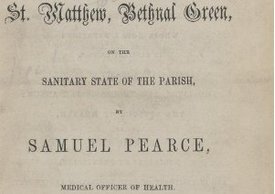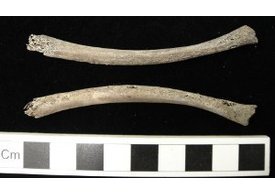An Unenviable Notoriety: 19th Century Life in Bethnal Green
AOC’s monograph on our excavations of a privately-owned 19th century burial ground in Bethnal Green is nearing completion. To help put the archaeological results in context, we researched surviving historical records to help build a picture of what life was like in the parish. Records from the 1841 and 1851 census allowed us to investigate the occupations of those buried in the ground and their surrounding family. Many were employed in the trades typical of the East End of London, including weaving, shoemaking, victualling, shopkeeping and trades, such as building, carpentry and metalworking.
The recent digitisation of mid 19th-century Medical Officer of Health Reports by the Wellcome Library has provided a tremendous resource of contemporary medical insights into sanitary conditions and causes of mortality across London. Reports by Samuel Pearce, Medical Officer of Health for St. Matthew, Bethnal Green from 1855-1856 and 1856-1857 refer to the period in which some of the excavated individuals lived. These direct observations have helped to expand on the interpretations that we can draw from the surviving physical remains of past Londoners.
Pearce attributed many cases of illness, including scarlet fever, typhus, smallpox and cholera, to open sewers (e.g. Nelson Street) and drains (e.g. Cambridge Circus) and drew awareness to the “disease-inviting back to back houses, including Alfred and Beckford Rows, and “pestilential blind alleys” in Gibraltar Walk, Church Street and Friar’s Mount. As these illnesses often cause death rapidly, there will be little indication of them on the skeletal remains. Correlating historical and osteological evidence together allows us to provide a more complete interpretation of health impacts from this population sample.
Pearce (1857) described the parish as “...being densely peopled by the poorest class and having but little breathing space.....while hundreds swarm like bees, in close, un-sunned, low-lying courts....”. This description of the parish is especially fitting as a large number of children were identified with vitamin D deficiency rickets caused by a lack of sunlight exposure and/or foods containing vitamin D including oily fish and eggs. Mothers who were deficient in vitamin D could contribute to rickets developing in their children while breastfeeding without exposure to the sun. In some examples, chronic under-nutrition and growth stunting had occurred indicating poor child care amid challenging living conditions.


